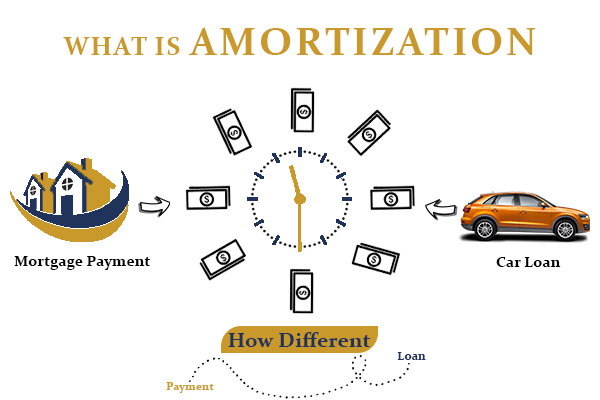Home >> Blog >> What Is Amortization And How Amortization Schedule Is Calculated?
What Is Amortization And How Amortization Schedule Is Calculated?

Table of Contents
- 1. Introduction
- 2. What is Amortization, in simple words?
- 3. How Does Amortization Work?
- 4. How To Calculate Amortization Of Intangible Assets With An Example
- 5. Difference Between Amortization And Depreciation (Amortization vs. Depreciation)
- 6. Why is the Amortization Schedule Important?
- 7. Bottom Line
1. Introduction
Amortization plays a very crucial role in any business. Amortization is an accounting technique or practice of writing off the value of intangible assets in business, such as patents or copyrights. Additionally, amortization schedule can affect a company's income statement, balance sheet, and tax liability.
It is noticed that the calculation of amortization is done mainly for accounting purposes. But when calculating amortization, it can be tough to determine which assets are intangible and which are not! Only after you have identified the intangible assets of your business can you calculate the correct amortized value.
Amortization for accounting purposes is regularly used in the world of finance. Amortization intends to ensure the loan's value and intangible assets over a specified period. It is also used to plan principal and interest payments so businesses can regularly pay interest for a secured and unsecured loan in installments. However, new businesses can sometimes need clarification while calculating amortization.
Just like every song or domain has a patent, it is essential for your business too. You can get trademarks, patents, licenses, and other intangible assets if you want to protect your business and operate it under the law. But, of course, it can be a bit expensive for a small business to obtain. Do you know you can reduce your taxable income for a lifetime by using amortization on intangible assets? So let's know about amortization in detail in this blog today.
2. What is Amortization, in simple words?
In its true sense, the term amortization describes the value of intangible assets or debts. You will be surprised to know that, like tangible assets, intangible assets also experience wear and tear. That is, intangible assets also lose their value and depreciate over time. The standard of living of intangible assets in a business is measured through contact termination and other factors. These intangible assets also need to provide value to run the business profitably. This whole process is known as amortization.
Repaying a loan while amortizing can also be considered principal plus interest. If an asset is amortized, it simply means that its value will be reduced over time. This shortfall is included in the balance sheet.
Like depreciation, amortization is also treated as a non-cash expense. That is, when amortization and depreciation are reported, there is no deduction in cash. Companies use a variety of tools to calculate amortization. Usually, financial institutions use an amortization schedule to offer loan repayment schedules based on the maturity date.
-
Two main Objectives of Amortization schedule
Are you aware of which of your assets can be amortized? From another perspective, you can only use an amortization schedule for certain business purchases.
Keep in mind that only intangible assets can be amortized. Of course, intangible assets do not have a physical presence, but they significantly contribute to your business. Therefore, if the life of an intangible asset is uncertain, it cannot be amortized. As such, the asset must have a certain lifetime for amortization to take place.
-
"Amortization" is used for two different situations. In the first case, the principal and interest must be paid regularly to repay the loan. Sometimes an amortization schedule is also implemented to reduce the current balance on the loan.
-
In the second case, amortization indicates the capital spread associated with a business's intangible assets over a specific period. Amortization schedule is often used in business for accounting and tax purposes.
3. How Does Amortization Work?
It cannot be denied that most assets lose their value over time. Amortization helps you determine the gradual loss of assets, which you can express in your accounting records and substantially reduce your taxable income.
It has been observed that when a property is performing consistently well or has brought in wealth for more than a year, many people want to write off the cost of that asset for a longer period. Using amortization allows you to match that property's expense to the revenue it generates each year. The repayment of the principal throughout the loan's duration is referred to as amortization. Amortization helps you divide the loan amount to be paid.
3.1 Amortization of A Loan
When a person takes a loan or an institution grants a loan, a definite series of payments is built when giving the loan. And the person who takes the loan is responsible for meeting each payment with interest. Amortization of the loan is also known as paying the outstanding amount.
Do you know that a loan's interest and the principal amount may change monthly, but the repayment amount is fixed during the repayment period?
3.2 Amortization of Assets or Business
Intangible assets are used in place of physical assets in amortization. For example, intellectual property, branding, etc. Depreciation results in a periodic decrease in amortization time, just like a decrease in value during the computation of fixed assets. Calculating amortization is challenging, as the actual cost and value of assets such as intellectual property and brand identity are not fixed.
4. How To Calculate Amortization Of Intangible Assets With An Example
To calculate amortization, let's assume you want to buy copyright rights for your business, which is worth Rs 2,00,000 and has a life of 20 years. In this way, you can calculate the amortization according to the formula given below:
|
Amortization per yr. = Purchase Price / Estimated Shell Life or useful years = INR 2,00,000/20yr = INR 10,000 |
You can report INR 10,000 to your account for copyright amortization.
It is usually most common to calculate amortization from the formula above. But companies or businesses that deal with debt (loan) and their accounting use the mathematical formula below to calculate amortization or payment amount per period.
Amortization Calculation For a loan
|
A = P x r(1+r)^n / (1+r)^n – 1 |
Where
-
A = amount payable
-
r = rate of interest
-
P = Principle
-
n = total no of payments
Let's say you wish to finance the purchase of an automobile with a starting price of $21,000. Then, you want to take $20,000 for 5 years, on which you have to pay interest at the rate of 7.5%, and you have already made a down payment of $1000. In this way, you can calculate how much in installation and how much will have to be paid per month.
P = $20,000
R = 7.5% p.a.
= 0.00625
n = 5 years * 12 months
Total Duration 60
Using the formula above, you must pay approximately $400.76 monthly.
5. Difference Between Amortization And Depreciation (Amortization vs. Depreciation)
-
Since amortization and depreciation are calculated over the same period, people often confuse the two because they do not understand the difference between amortization and depreciation. Amortization and depreciation support the GAAP matching principle to identify expenses incurred during the period to help them generate revenue. There is a significant difference between amortization and depreciation.
-
Amortization is used for intangible assets, while depreciation is used for tangible assets. Also, depreciation is used for fixed assets such as office buildings, equipment or vehicles, etc.
-
Typically, circumstances such as contract termination or obsolescence of an intangible asset represent a loss of the intangible asset at the time of amortization. On the other hand, when fixed assets deteriorate or are consumed, they lose their value. Depreciation reflects this.
-
Amortization only applies to intangible assets with fixed and identifiable useful lives. Amortization does not apply to intangible assets that have an indefinite useful life. In comparison, depreciation can be generated for all other immovable assets except land.
-
While computing depreciation, it is assumed that a fixed asset has a salvage value. At the same time, amortization is usually calculated on the entire value of intangible assets.
6. Why is the Amortization Schedule Important?
-
Amortization is necessary because it helps businesses understand and forecast their costs promptly. Amortization helps businesses to understand their cost of capital as well as manage cash flow. That makes it easier to plan expenses.
-
With the help of the amortization schedule, you get a clear picture of the loan repayment schedule; that is, you get a better understanding of which portion of the loan payment includes interest versus principal.
-
Amortization helps business owners with accounting and bookkeeping. It helps in a systematic and linear accounting for each asset, tangible or intangible, so that the recipient gets the full value of his purchase or asset.
-
The amortization process for intangible assets can sometimes be tedious, but amortization is best used to write off debt values and intangible assets. Since it is not the same as depreciation, it is used for accounting and taxation purposes.
-
There is also truth in the fact that amortization can prove beneficial to cut interest payments as well. Since amortization can reduce a business's taxable income, investors can make an investment decision by understanding the business's actual earnings.
7. Bottom Line
Finally, amortization schedule refers to writing off the value of a debt or intangible asset. An amortization schedule is an essential tool for any business or financial institution to understand the costs and profitability of the business. And also, prepare a chart for the borrower that shows them how and when to pay off the loan. For how long will it take? It helps businesses to record the amount spent on intangible assets such as copyrights, licenses, and patents. Using an amortization schedule example, you can understand the cost of an asset, which gradually decreases over time.
Frequently Asked Questions
An amortization schedule is implemented to reduce the current balance on loans and business for accounting and tax purposes.
Amortization helps businesses to understand their cost of capital as well as manage cash flow. That makes it easier to plan expenses.
Simply put, depreciation is the process of deducting the cost of a business asset over a longer period rather than one year.



















